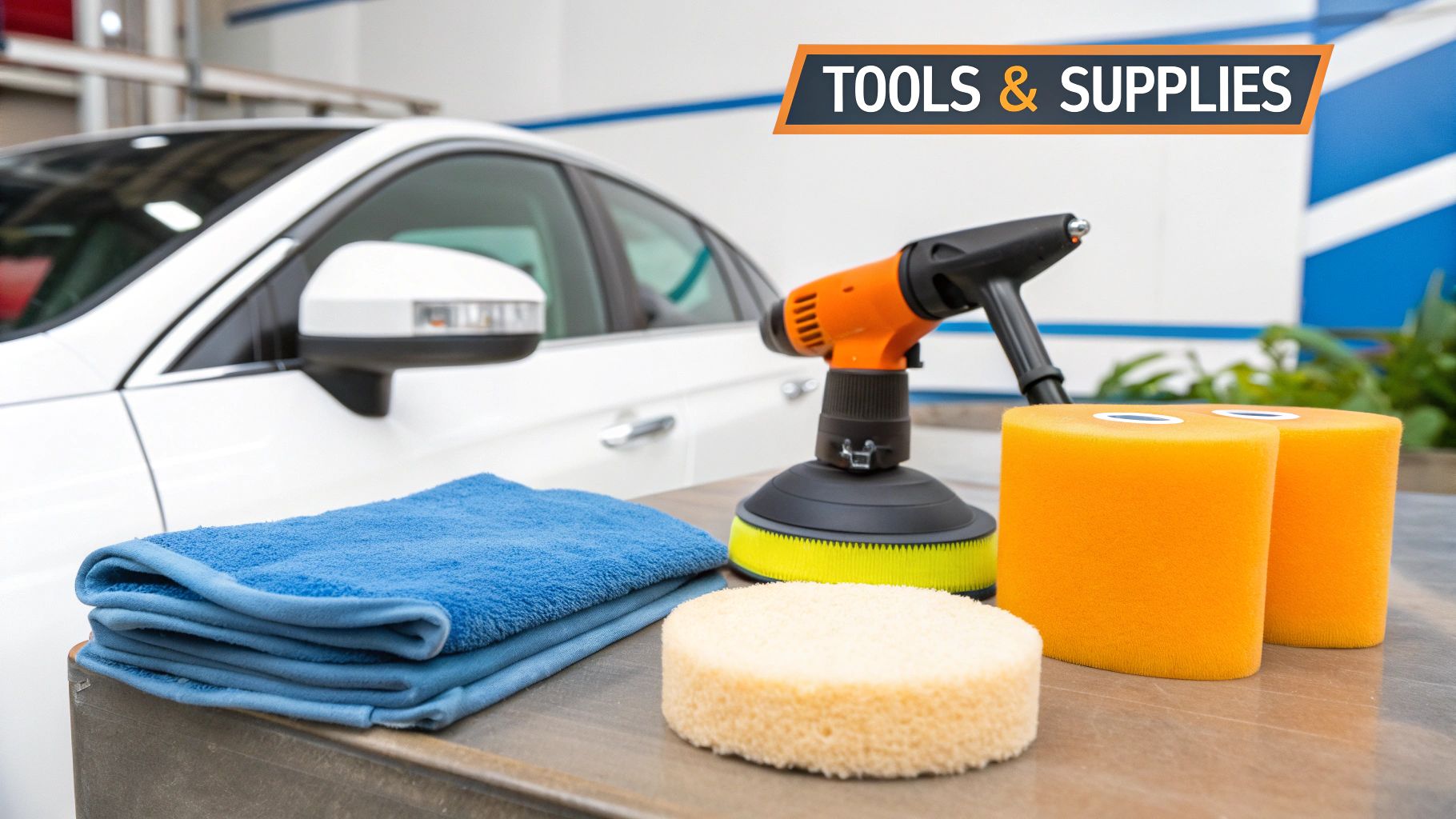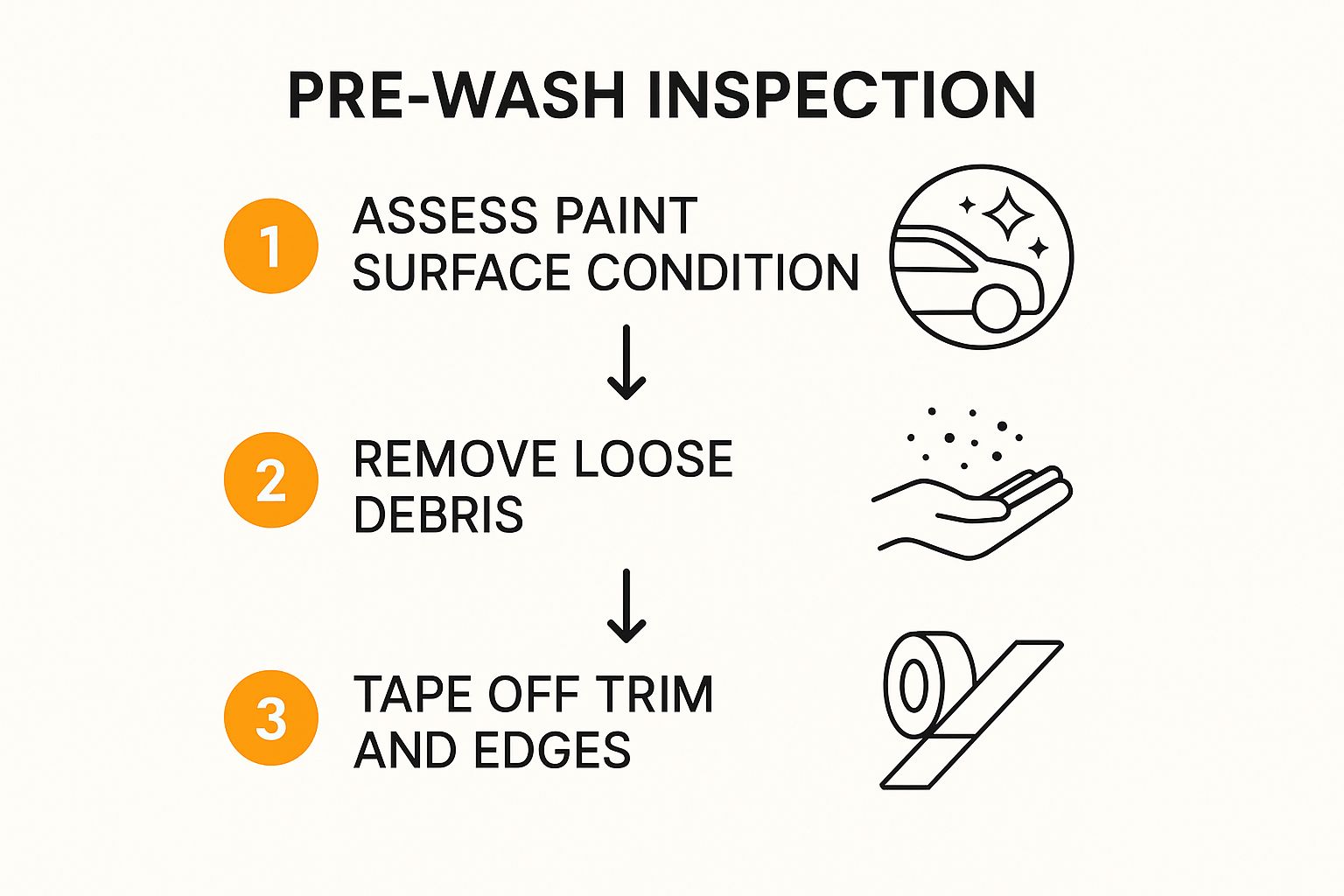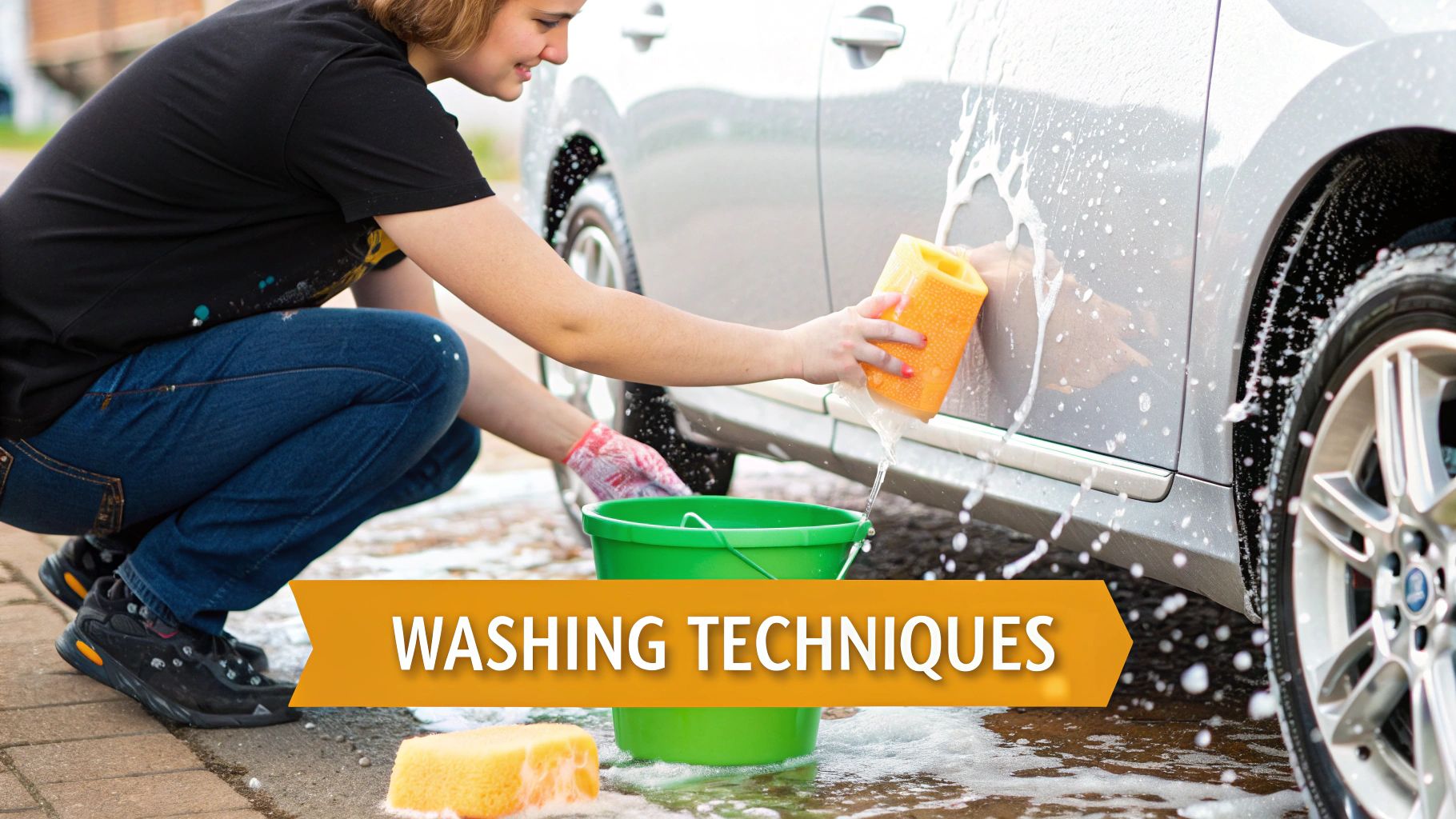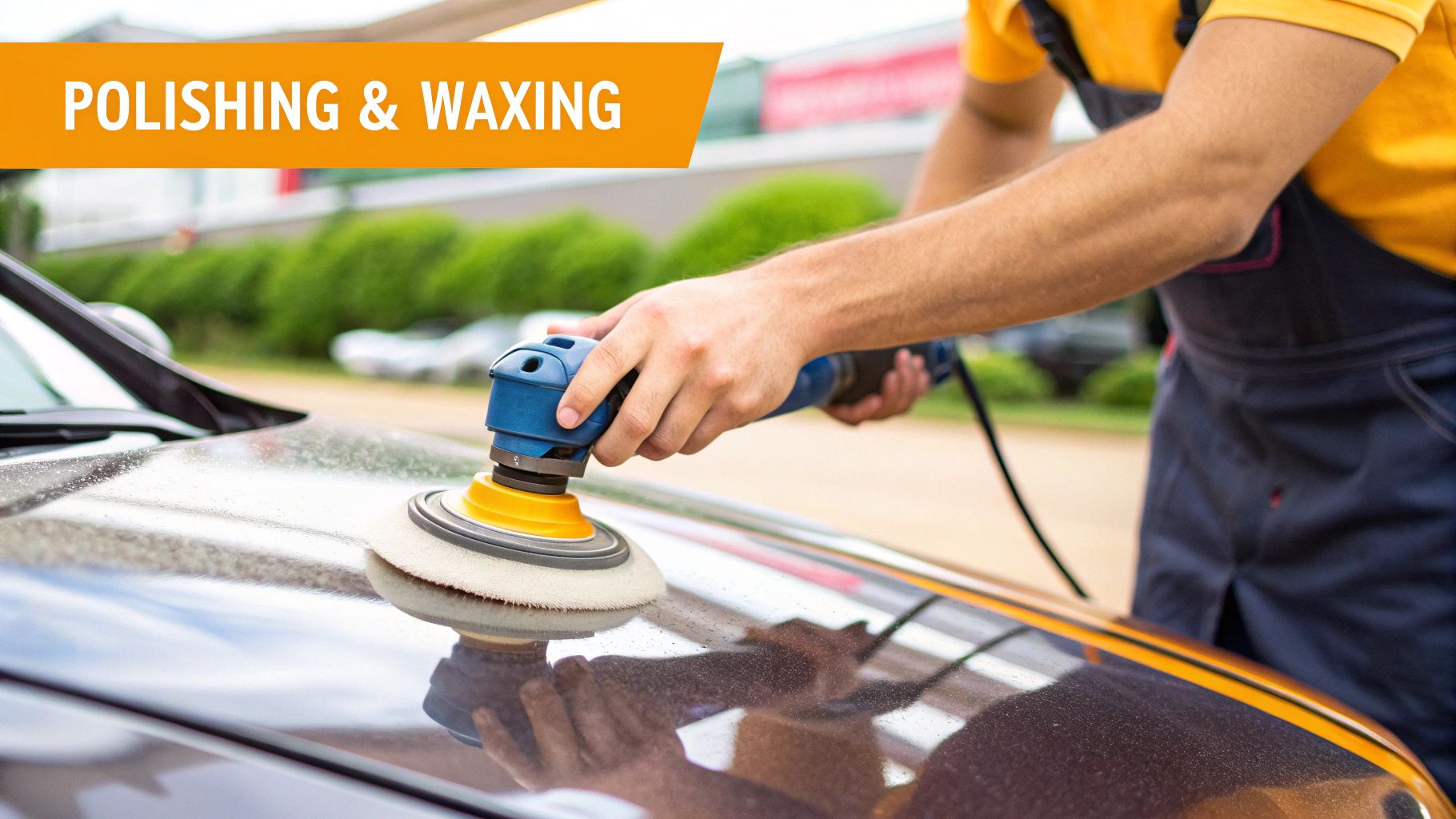The Art of Car Detailing: What Beginners Really Need to Know
Car detailing can seem intimidating for beginners. It's much more involved than a simple car wash; it's a meticulous process of preserving your car's value and enhancing its appearance. The goal isn't overnight perfection, but rather understanding the key principles that distinguish a basic wash from true detailing. For more information, you might be interested in this resource: How to master...
Understanding the Detailing Mindset
Newcomers to car detailing can easily feel overwhelmed by the variety of products and techniques available. Experienced detailers, however, stress that the right mindset is just as important. It's about appreciating the process and recognizing that detailing is an ongoing activity, not a one-time fix. This means concentrating on gradual improvements and developing your skills over time.
Demystifying Detailing Terminology
The detailing world has its own unique vocabulary. Terms like clay bar, paint correction, and ceramic coating can be confusing at first. Understanding these terms is essential for choosing the right products and methods for your car. For instance, a clay bar is used to lift embedded contaminants from your car's paint, while paint correction involves eliminating swirl marks and other imperfections.
Setting Realistic Expectations
While detailing can dramatically improve your car's look, it's important to have realistic expectations. Detailing isn't a magical solution; it can't make a heavily damaged car look brand new. It can, however, significantly enhance its shine, protect its paint, and make it a more enjoyable car to own. The car detailing industry is also experiencing significant growth. The U.S. car wash and auto detailing market is expected to reach $20.2 billion in 2025, a 1.9% increase from 2024. This growth is fueled by consumer demand for convenience, advanced vehicle care, and environmentally friendly options. You can find more detailed statistics from the International Carwash Association: Detailing Industry 2025. Capturing high-quality photos is a great way to showcase your detailing work. For tips on improving your car photography, check out this article: How to Edit Car Photos.
Focusing on the Fundamentals
Beginners should prioritize mastering the fundamental skills first. This includes proper washing and drying techniques, interior cleaning, and basic paint protection. As your skills develop, you can then explore more advanced techniques like paint correction and ceramic coatings. This gradual approach helps build a solid foundation before moving on to more complex procedures.
Building Your Detailing Arsenal Without Breaking the Bank

Starting your car detailing journey doesn't have to be expensive. Many beginners overspend on products they rarely use. This section focuses on building a smart, cost-effective detailing kit that emphasizes quality over quantity. We'll cover the essential tools and explain why investing in certain items, like a high-quality wash mitt, is vital, while others can be more budget-friendly.
Essential Tools: Quality Over Quantity
For beginners, a few key, high-quality items are more beneficial than a large collection of cheap products. This allows you to master proper techniques without unnecessary expense. A premium microfiber wash mitt, for example, holds more suds, minimizes swirl marks, and lasts longer than a cheaper version. Similarly, investing in a good drying towel prevents water spots and scratches.
- Microfiber Wash Mitt: This is your primary paint contact point, so quality matters. Look for a plush, deep-pile mitt designed for car washing.
- Drying Towels: A large, absorbent microfiber drying towel is essential for a spot-free finish. Waffle-weave towels offer superior drying capabilities.
- Two Buckets: The two-bucket wash method is fundamental. One bucket holds soapy water, the other clean rinse water. This prevents cross-contamination and reduces swirls.
- Car Wash Soap: Use a pH-neutral soap formulated for cars. Avoid dish soap, which can strip wax and damage your car's finish.
- Applicator Pads: These are helpful for evenly applying waxes, sealants, and other protectants.
Smart Shopping: Where to Save and Where to Splurge
Understanding product marketing can save you money. Many products target beginners with inflated promises. However, professional detailers often achieve stunning results with a few select products. This means you can save money by avoiding unnecessary purchases.
- Wheel Cleaner: A basic wheel cleaner is sufficient for most beginners. You don't need the priciest option for clean wheels.
- All-Purpose Cleaner: One good all-purpose cleaner can handle both interior and exterior cleaning, eliminating the need for multiple cleaners.
- Detailing Brushes: Various brushes exist for different detailing tasks. Start with a few essential brushes and expand as needed.
The table below summarizes essential detailing supplies, their purpose, estimated cost, and necessity level.
Essential Detailing Supplies for Beginners: A comprehensive list of must-have supplies for beginners, categorized by purpose with price ranges.
| Item | Purpose | Estimated Cost Range | Necessity Level |
|---|---|---|---|
| Microfiber Wash Mitt | Washing | $5-$15 | Essential |
| Drying Towels | Drying | $10-$30 | Essential |
| Two Buckets | Wash/Rinse | $5-$10 | Essential |
| Car Wash Soap | Washing | $5-$20 | Essential |
| Applicator Pads | Applying Products | $5-$10 | Essential |
| Wheel Cleaner | Cleaning Wheels | $8-$20 | Recommended |
| All-Purpose Cleaner | Cleaning Interior/Exterior | $5-$15 | Recommended |
| Detailing Brushes | Various Cleaning Tasks | $5-$20 | Recommended |
This table provides a starting point for building your detailing kit. Remember, quality matters for core items, but you can save on others.
Building Your Arsenal Over Time
Car detailing is a progressive hobby. Your product needs will change as your skills and interests grow. Don't feel pressured to buy everything at once. Begin with the essentials and gradually expand your collection. The car detailing market is constantly evolving, reflecting consumer demand. For example, the market for creative detailing goods and premium services is projected to grow by 10.3% between 2024 and 2025, reaching $1.68 billion. Factors driving this growth include health and safety concerns, sustainable detailing practices, advancements in ceramic coatings, and the increasing number of luxury cars. Explore this topic further: Find more detailed statistics here. Starting with the basics allows you to experiment and discover what best suits you and your car.
Exterior Detailing Mastery: From Rinse to Shine
Transforming your car's appearance goes beyond a simple wash; it's about understanding the meticulous process of detailing. This isn't just about achieving a showroom shine, but also preserving your car's paint and protecting its value. For those new to car care, mastering exterior detailing is the first step towards becoming a true automotive aficionado.
Pre-Wash Preparation: The Foundation of a Flawless Finish
Before you even consider reaching for the soap, the pre-wash stage is paramount. This crucial step involves a systematic approach to assess, remove, and protect your car's delicate surfaces. The following infographic illustrates the key steps involved in a pre-wash inspection:

This three-step process ensures a pristine starting point. Assessing the paint condition reveals any pre-existing damage, removing loose debris prevents scratching during the wash, and taping off trim protects it from harsh chemicals. This pre-wash routine sets the stage for a swirl-free, professionally detailed finish.
The Two-Bucket Wash Method: Minimizing Swirl Marks
The two-bucket wash method is a fundamental technique in professional detailing. It minimizes swirl marks—those fine scratches that dull your car's finish. One bucket holds your car wash soap solution, the other clean water for rinsing your wash mitt. This prevents transferring dirt back onto the paint. Think of it like washing dishes—you wouldn't wash a plate and then dip it back into the dirty water. This simple method drastically reduces the risk of scratching.
Drying Techniques: Preventing Water Spots
Drying your car isn’t simply about removing water; it’s about preventing unsightly water spots, particularly noticeable on darker paint. Use a large, absorbent microfiber drying towel—a waffle-weave towel is ideal for maximum absorption. Work in straight lines, avoiding circular motions, to minimize streaking. A drying aid, a spray-on product that helps sheet water off the surface, can further reduce the chance of water spots. For more information on efficient drying, consider resources like How to master..., which explores using foam guns for drying.
Tackling Wheels and Trim: Specialized Approaches
Wheels and trim often require specific cleaning solutions due to brake dust, road grime, and other stubborn contaminants. A dedicated wheel cleaner and appropriate brushes are essential to avoid damaging these surfaces. For trim, a gentle all-purpose cleaner will remove dirt and restore its original appearance. The goal is not just cleanliness, but also preservation of these components.
Clay Bar Treatment: When and How
A clay bar treatment removes embedded contaminants that washing alone can’t tackle. It’s not always necessary, but if your car's paint feels rough after washing, a clay bar treatment can be highly beneficial. Use a dedicated clay bar lubricant to ensure smooth gliding and prevent scratching. This process refines the paint surface before polishing or applying protection, creating a smooth and shiny finish.
Troubleshooting Common Exterior Issues
Even with meticulous preparation, issues like stubborn bug residue or water spots can arise. For bugs, a dedicated bug remover, allowed to dwell for a few minutes before washing, is effective. Water spots can often be removed with a quick detailer spray. If they persist, a light polish may be necessary. Understanding these troubleshooting techniques allows you to address common problems effectively, shifting the focus from simply cleaning to proactively protecting your vehicle's appearance.
To further illustrate the differences between a basic wash and a proper detailing approach, let's take a look at the following comparison:
Exterior Detailing Process Comparison: Comparison of basic washing versus proper detailing steps and their benefits
| Process Stage | Basic Wash Approach | Proper Detailing Approach | Benefits of Proper Detailing |
|---|---|---|---|
| Pre-Wash | Rinse with water | Thorough rinse, debris removal, trim protection | Minimizes scratches, prepares surfaces for cleaning |
| Wash | Single bucket wash | Two-bucket wash method | Reduces swirl marks, prevents recontamination |
| Dry | Air dry or towel dry | Microfiber towel dry, drying aid | Prevents water spots, enhances shine |
| Wheels & Trim | May use same soap as car wash | Dedicated wheel cleaner, appropriate brushes, all-purpose cleaner for trim | Protects against damage, restores original appearance |
| Decontamination | None | Clay bar treatment (as needed) | Removes embedded contaminants, creates smoother surface |
| Post-Wash | None | Inspection, touch-ups | Ensures complete cleanliness, addresses any remaining issues |
This table highlights the key differences between a basic wash and a full detail. While a basic wash cleans the surface, detailing delves deeper, addressing embedded contaminants and protecting vulnerable areas for a truly pristine finish. By understanding these distinctions, you can elevate your car care routine and ensure your vehicle looks its best.
Interior Transformation: Creating a Cabin You'll Love

The interior of your car is where you spend most of your driving time. Detailing this space isn't just about cleaning; it's about crafting a comfortable and enjoyable driving environment. For beginners, interior car detailing can feel overwhelming. But with a systematic approach and the right techniques, you can achieve professional results. This section will guide you through transforming your car's interior into a space you'll truly appreciate.
Starting From the Top: A Systematic Approach
Professional detailers always follow a top-to-bottom cleaning method. This simple strategy prevents recontamination as dirt and dust naturally fall downwards. Begin by cleaning the headliner. Then, move to the dashboard, followed by the seats. Finally, tackle the carpets and floor mats. This methodical approach ensures every surface receives a thorough and efficient cleaning.
Material Matters: Tailoring Your Technique
Modern car interiors incorporate a range of materials, each demanding specific cleaning techniques. For delicate touchscreens and infotainment systems, use a microfiber cloth and a dedicated screen cleaner. Avoid using harsh chemicals, which can damage sensitive electronics. Leather requires gentle cleaning and conditioning to maintain its suppleness and prevent cracking. Fabric upholstery can be cleaned with specialized fabric cleaners and brushes. Understanding your car's interior materials is key to effective cleaning.
Beyond Cleaning: Odor Elimination and Bio-Contamination
Effective interior detailing also involves addressing embedded odors and potential bio-contamination. Instead of masking smells with air fresheners, focus on eliminating the odor's source. Specialized odor eliminators neutralize the odor-causing molecules at the source. Cleaning frequently touched surfaces like the steering wheel, door handles, and gear shifter with a disinfectant helps reduce bacteria and viruses. This not only creates a fresher-smelling cabin, but also a healthier one.
Product Selection: Separating the Essential from the Overhyped
The market is saturated with interior detailing products, which can make choosing the right ones challenging for beginners. Some products, like all-purpose cleaners and quality microfiber towels, are essential. Others may be overhyped and offer minimal benefit. Focus on building a core collection of effective products that meet your specific needs. This targeted approach saves you money and prevents product clutter. The global car detailing service market, valued at $36.7 billion in 2024, is projected to grow at a 5.7% CAGR between 2025 and 2034. This growth is fueled by factors such as urbanization, the increasing number of premium vehicles, and the rising popularity of electric cars. Find more detailed statistics here.
Maintaining Your Interior: Creating a Sustainable Routine
Finally, establish a sustainable interior maintenance routine that fits your vehicle usage and lifestyle. Regularly vacuuming, wiping down surfaces, and promptly addressing spills prevents dirt buildup. This, in turn, makes deep cleaning less frequent and less time-consuming. Consistent maintenance not only keeps your interior looking its best but also preserves your car's value. Mastering these basic interior detailing techniques will transform your car's cabin into a clean, comfortable, and inviting space.
Protection Strategies: Making Your Hard Work Last
After meticulously cleaning your car, protecting your hard work is the next critical step. This is where many beginners stumble, often misunderstanding the available protection products. This section clarifies the differences between these products, helping you develop a protection strategy that suits your car, your climate, and your detailing goals.
Understanding Your Protection Options
Beginner car detailers often face a choice between several different protectants. These include carnauba waxes, synthetic sealants, ceramic coatings, and paint protection films (PPF). Each offers a unique balance of protection and longevity. Carnauba waxes, derived from palm trees, give a warm, deep gloss but typically only last a few weeks. Synthetic sealants, engineered for durability, can last several months, providing a slick, reflective finish.
Choosing The Right Protection For Your Needs
Several factors influence the best protection for your car. Consider your local climate, driving conditions, and how often you wash your car. If you live in a harsh climate or frequently drive on unpaved roads, a more durable protectant like a synthetic sealant or ceramic coating might be a wise investment. If you love that deep, warm glow and enjoy the process of regular waxing, carnauba wax remains an excellent choice. For ultimate protection against rock chips and scratches, PPF provides a physical barrier, though it represents a more significant investment.
Application Techniques and Common Mistakes
Proper application is essential for maximizing protection. Whether applying wax, sealant, or a ceramic coating, always work in small sections and carefully follow the manufacturer's instructions. Avoid applying product in direct sunlight or on a hot surface, as this can cause streaking and uneven application. Using too much product can also make removal difficult and hinder effectiveness.
Professional Detailing: A Layered Approach
Professional detailers often employ a layered approach to protection, perhaps starting with a sealant for durability and then adding a layer of carnauba wax for enhanced gloss. This combines the strengths of both products, maximizing protection and visual appeal. You might be interested in this article which explores various car care approaches: How to master.... This layered approach creates robust protection for your car’s paint, with the sealant acting as a durable foundation and the wax providing a final layer of defense and shine.
Realistic Expectations and Maintenance
No car protection product lasts indefinitely. Even ceramic coatings need regular maintenance and eventual reapplication. Understanding the realistic lifespan of your chosen product allows you to plan your detailing schedule effectively. Regular washing with a pH-neutral car wash soap helps maintain the protective layer and prolong its effectiveness, ensuring your car looks its best and stays protected from the elements.
Troubleshooting Like a Pro: Fixing Detailing Disasters

Even seasoned car detailing professionals make mistakes. This section helps beginners avoid those same pitfalls by learning from the pros. We'll explore diagnostic techniques and recovery methods, covering everything from simple fixes to more advanced solutions.
Diagnosing Common Detailing Problems
A systematic approach to troubleshooting detailing problems saves you time and prevents further damage. Water spots, often appearing as circular marks (especially on dark paint), are usually caused by hard water drying on the surface. Product hazing, a milky film, can result from using too much product or incorrect application. Streak marks are often visible after washing or drying, indicating improper technique or dirty tools. Correctly identifying the problem is the first step towards fixing it.
Recovering From Detailing Mishaps
For water spots, a quick detailer spray and a clean microfiber towel often does the trick. More stubborn spots may require a dedicated water spot remover. Product hazing can often be removed by rewashing the affected area with car wash soap and ensuring thorough rinsing. If it persists, a dedicated product remover may be necessary. For streak marks, rewashing and drying using the correct technique often solves the problem. This highlights the importance of clean, high-quality microfiber towels and proper product application.
Water Spotting: Causes and Solutions
Water spotting is a common frustration for beginners, typically caused by minerals in hard water left behind as the water evaporates. Here are a few prevention and treatment tips:
- Drying Aid: Use a drying aid to help sheet water off the paint, minimizing spots.
- Filtered Water: If possible, rinsing with filtered water reduces mineral deposits.
- Quick Detailer: A quick detailer spray can often remove minor water spots.
- Water Spot Remover: For stubborn spots, a dedicated water spot remover may be required.
These techniques offer various options for tackling water spots, allowing you to choose the best approach for your situation.
Product Hazing: Prevention and Removal
Product hazing, often a milky film, can be caused by several factors. Here’s how to avoid and remove it:
- Less is More: Use product sparingly. Too much product increases the chance of hazing.
- Even Application: Apply products evenly, especially waxes and sealants.
- Proper Removal: Always follow the manufacturer’s instructions for product removal.
- Panel Wipes: Consider using panel wipes to remove any remaining residue.
These preventive and removal techniques offer practical solutions for dealing with hazing, emphasizing proper application and thorough removal.
The Psychology of Detailing Frustration
Detailing can be challenging, and setbacks are inevitable. View these as learning opportunities, not failures. Experienced detailers stress the importance of patience and persistence. Start with basic techniques and gradually progress to more advanced methods as you improve. This approach builds skills and minimizes frustration. Learning from mistakes is part of the process.
Advanced Troubleshooting Techniques
For more serious problems like scratches or swirls, paint correction may be necessary. This involves using a machine polisher and specialized compounds to remove imperfections and restore clarity. However, machine polishing is best left to professionals. Attempting this without proper training and equipment can cause further damage. As a beginner, focus on preventing these issues by mastering proper washing and drying techniques and using appropriate protection products.
Creating a Detailing Routine That Actually Works For You
Consistency is key for car detailing, especially for beginners. It’s the difference between viewing detailing as a chore and enjoying it as a rewarding hobby. This section will help you understand how to develop a sustainable routine adapted to your lifestyle, how frequently you drive, and even the specific environmental challenges of your area.
Balancing Quick Maintenance and Deep Cleans
Effective car detailing routines find a balance between quick maintenance and more thorough detailing sessions. Think of it like personal health: you strive for healthy eating habits and schedule regular doctor appointments. Similarly, washing your car weekly and detailing it a few times a year protects its value and keeps it looking its best. This prevents dirt from accumulating and makes deep cleaning much easier.
- Weekly Routine: Quickly wash, dry, and wipe down the interior to keep your car looking great.
- Monthly Routine: Once a month, take the extra time to clean your wheels and apply tire dressing.
- Quarterly Routine: Every three months, perform a complete exterior and interior detail, including decontamination and applying protectants.
This schedule is a flexible starting point. Feel free to adjust it based on your specific needs and how often you use your vehicle.
Adapting to Seasonal Changes
Your car care routine should change with the seasons, just like your wardrobe. Winter brings road salt and grime, which means more frequent washing and undercarriage cleaning are a must. The intense sun and heat of summer require extra attention to paint protection. You may need to adjust your product choices and detailing techniques. For instance, applying a sealant with UV protection during the summer can prevent sun damage to your car’s finish.
Staying Motivated: Finding the Joy in Detailing
Motivation is key for sticking to any routine. One way to stay motivated is by focusing on the immediate results of your detailing efforts. The transformation from dirty to clean can be incredibly satisfying. As you refine your techniques and improve your skills, you’ll find even more motivation in the results. Joining online detailing communities or attending local car meets can provide additional inspiration and allow you to share tips with other enthusiasts.
Personalizing Your Routine for Long-Term Success
The best detailing routine is one you can maintain. This means personalizing it to fit your lifestyle, the time you have available, and the resources you have access to. If time is limited, concentrate on the most important tasks. If you live in an apartment with shared washing facilities, adapt your methods accordingly. Flexibility and personalization are essential for long-term success.
Creating a Routine That Works For You
- Assess Your Lifestyle: Consider your available time, driving habits, and local climate.
- Prioritize Tasks: What are the most important tasks for your car's current condition and your personal priorities?
- Schedule Regular Maintenance: Establish achievable goals and create a regular cleaning schedule you can follow.
- Track Your Progress: Take note of how your car's appearance improves to maintain your motivation.
- Seek Support: Join online detailing forums or connect with local detailers for guidance and encouragement.
By following these suggestions, you can create a car detailing routine that’s not only effective but also enjoyable, turning car care into a fulfilling hobby.
Ready to enjoy a truly clean car? The SwiftJet Car Wash Foam Gun makes washing your car quicker and easier than ever. Check it out!
